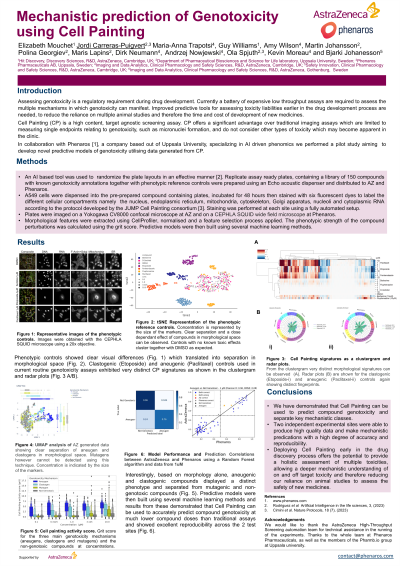Frontiers in Technology
Poster Session B
(1087-B) Mechanistic prediction of Genotoxicity using Cell Painting
Wednesday, May 29, 2024
10:30 - 11:15 CEST
Location: Exhibit Hall


Jordi Carreras Puigvert (he/him/his)
Associate Professor - CSO
Uppsala University - Phenaros Pharmaceuticals
Uppsala, Uppsala Lan, Sweden
Poster Presenter(s)
Abstract: The assessment of genotoxicity is a regulatory requirement during the drug discovery process, whereby the potential carcinogenic risk of drug candidates must be evaluated. Genotoxic damage encompasses DNA mutations, changes in chromosome number and chromosomal aberrations or DNA strand breaks; all of which may contribute to carcinogenesis.
Current assays used for the regulatory assessment of genotoxicity are very expensive, low throughput and necessitate testing of compounds in animals. There is a real need to develop improved predictive tools for the assessment of toxicity liabilities earlier in the drug development process thus removing the need for multiple animal studies and reduce the time and cost of development of new medicines.
The aim of our work was to develop a predictive model of genotoxicity utilising data generated from a target agnostic, high-content and high throughput screening assay known as Cell Painting. Unbiased phenotypic methods such as Cell Painting offer a significant advantage over traditional hypothesis-driven imaging assays which are limited to the measurement of specific single endpoints relating to genotoxicity (e.g., measurement of micronuclei formation) and do not consider other types of toxicity which could then become apparent in the clinic.
For this purpose, lung cancer A549 cells were exposed to a reference library of 150 compounds, in a dose response manner, for 48 hours then stained with six fluorescent dyes to label different cellular compartments, including the nucleus, endoplasmic reticulum, mitochondria, cytoskeleton, Golgi apparatus, nucleoli and cytoplasmic RNA. Morphological features were calculated with Cell Profiler, normalised, and a feature selection process was applied. The overall morphological changes induced by the activity of each individual compound was evaluated using the grit score, which demonstrated separation of aneugenic and clastogenic compounds from mutagenic and non-genotoxic compounds based on morphology alone. Predictive models were then built using several machine learning methods and results from these demonstrated that Cell Painting can be used to accurately predict compound genotoxicity at much lower compound doses than traditional assays.
Deploying Cell Painting early in the drug discovery process offers the potential to provide a holistic assessment of multiple toxicities, allowing a deeper mechanistic understanding of on and off target toxicity and therefore reducing our reliance on animal studies to assess the safety of new medicines.
Current assays used for the regulatory assessment of genotoxicity are very expensive, low throughput and necessitate testing of compounds in animals. There is a real need to develop improved predictive tools for the assessment of toxicity liabilities earlier in the drug development process thus removing the need for multiple animal studies and reduce the time and cost of development of new medicines.
The aim of our work was to develop a predictive model of genotoxicity utilising data generated from a target agnostic, high-content and high throughput screening assay known as Cell Painting. Unbiased phenotypic methods such as Cell Painting offer a significant advantage over traditional hypothesis-driven imaging assays which are limited to the measurement of specific single endpoints relating to genotoxicity (e.g., measurement of micronuclei formation) and do not consider other types of toxicity which could then become apparent in the clinic.
For this purpose, lung cancer A549 cells were exposed to a reference library of 150 compounds, in a dose response manner, for 48 hours then stained with six fluorescent dyes to label different cellular compartments, including the nucleus, endoplasmic reticulum, mitochondria, cytoskeleton, Golgi apparatus, nucleoli and cytoplasmic RNA. Morphological features were calculated with Cell Profiler, normalised, and a feature selection process was applied. The overall morphological changes induced by the activity of each individual compound was evaluated using the grit score, which demonstrated separation of aneugenic and clastogenic compounds from mutagenic and non-genotoxic compounds based on morphology alone. Predictive models were then built using several machine learning methods and results from these demonstrated that Cell Painting can be used to accurately predict compound genotoxicity at much lower compound doses than traditional assays.
Deploying Cell Painting early in the drug discovery process offers the potential to provide a holistic assessment of multiple toxicities, allowing a deeper mechanistic understanding of on and off target toxicity and therefore reducing our reliance on animal studies to assess the safety of new medicines.
